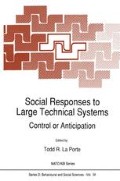Abstract
The tentativeness of my title is wholly deliberate. This paper is a report on work in progress. Though some features of the development of supercomputing already emerge clearly from the research, others take the form of tantalizing glimpses of possible patterns.
Access this chapter
Tax calculation will be finalised at checkout
Purchases are for personal use only
Preview
Unable to display preview. Download preview PDF.
References
Arthur, W. Brian. 1984. “Competing Technologies and Economic Prediction.” Options, pp. 10–13.
Barnes, Barry. 1983. “Social Life as Bootstrapped Induction.” Sociology 17: 524–45.
Barnes, George H.; Brown, Richard M.; Kato, Maso; Kuck, David J.; Slotnick, Daniel J.; and Stokes, Richard A. 1964. “The ILLIACIV Computer.” IEEE Transactions on Computers C-17, 8: 746–57.
Bashe, Charles J.; Johnson, Lyle R.; Palmer, John H.; and Pugh, Emerson W. 1986. IBM’s Early Computers. Cambridge, Mass.: MIT Press.
Bloor, David. 1982. “Durkheim and Mauss Revisited: Classification and the Sociology of Knowledge.” Studies in the History and Philosophy of Science 13: 267–97.
Broad, William J. 1985. Star Warriors. New York: Simon and Schuster.
Cray, Seymour. 1988. “What’s All This About Gallium Arsenide.” Videotape recording.
Donaghue, Hugh. 1987. “A Business Perspective on Export Controls.” In Selling the Rope to Hang Capitalism? The Debate on West-East Trade & Technology Transfer, ed. Charles M. Perry and Robert L. Pfaltzgraff, Jr. Washington, D.C.: Pergamon-Brassey.
Dosi, Giovanni. 1982. “Technological Paradigms and Technological Trajectories: A Suggested Interpretation of the Determinants of Technical Change.” Research Policy 11: 147–62.
Durkheim, Emile, and Mauss, Marcel. 1963. Primitive Classification. London: Cohen and West; first published in French in 1903.
Falk, Howard. October 1976. “Reaching for a Gigaflop.” IEEE Spectrum 13, 10: 65–69.
Flynn, Michael J. 1972. “Some Computer Organizations and their Effectiveness.” IEEE Transactions on Computers C-21, 9: 948–60.
Hewitt, Carl. 1977. “Viewing Control Structures as Patterns of Passing Messages.” Artificial Intelligence 8: 323–64.
Hewitt, Carl. 1985. “The Challenge of Open Systems.” Byte (April).
Hockney, R. W., and Jesshope, C. R. 1988. Parallel Computers 2: Architectures, Programming and Algorithms. Bristol: Adam Hilger.
Hughes, Thomas P. 1983. Networks of Power: Electrification in Western Society, 1880–1930. Baltimore: Johns Hopkins University Press.
Hurd, Cuthbert C. April 1985. “A Note on Early Monte Carlo Computations and Scientific Meetings.” Annals of the History of Computing 7, 2: 141–55.
Institute of Electrical and Electronics Engineers [IEEE]. 1981. IEEE Transactions on Systems, Man, and Cybernetics SMC-11, 1. (Issue on “Natural and Social System Metaphors for Distributed Problem Solving.”)
Ibbett, R. N., and Topham, N. P. 1989. Architecture of High Performance Computers. Basingstoke: Macmillan.
Intel Scientific Computers. 1989. “Intel, DARPA to Develop Prototype of 2000-Processor System Using New Intel Superchip.” Swindon, U.K.: Intel Corporation.
Johnson, Tim, and Durham, Tony. 1986. Parallel Processing: The Challenge of New Computer Architectures. London: Ovum.
Latour, Bruno. 1987. Science in Action: How to Follow Scientists and Engineers through Society. Milton Keynes, Bucks.: Open University Press.
Merton, Robert K. 1948. “The Self-Fulfilling Prophecy.” Antioch Review 8: 193–210; reprinted in Merton, Social Theory and Social Structure (New York: Free Press, 1968).
Metropolis, N. 1987. “The Los Alamos Experience, 1943–1954.” Paper presented to the ACM Conference on History of Scientific and Numeric Computation. Los Alamos, New Mexico: Los Alamos National Laboratory, LA-UR-87-1353.
Metropolis, N., and Ulam, S. 1949. “The Monte Carlo Method.” Journal of the American Statistical Association 44, 247 (September): 335–401.
Molina, Alfonso. 1989. Transputers and Transputer-Based Parallel Computers: Sociotechnical Constituencies and the Build-Up of British-European Capabilities in Information Technologies. Edinburgh: Programme in Information and Communication Technologies.
Nelson, Richard R., and Winter, Sidney G. 1982. An Evolutionary Theory of Economic Change. Cambridge, Mass.: Harvard University Press.
Noyce, Robert N. 1980. “Microelectronics.” In The Microelectronics Revolution, ed. Tom Forester. Oxford: Blackwell; first published in Scientific American 237, 3 (September 1977).
Nuclear Weapons Databook Project. 1988. “Nuclear Notebook: Known Nuclear Tests by Year, 1945 to December 31, 1987.” Bulletin of the Atomic Scientists 44, 2: 56.
Pavitt, Keith. 1984. “Sectoral Patterns of Technical Change: Towards a Taxonomy and a Theory.” Research Policy 13: 342–74.
Pease, Marshall C. 1977. “The Indirect Binary n-Cube Microprocessor Array.” IEEE Transactions on Computers C-26, 5: 458–73.
Seitz, Charles L. 1985. “The Cosmic Cube.” Communications of the ACM 28, 1: 22–33.
Shankar, Ravi, and Fernandez, Eduardo B. 1989. VLSI and Computer Architecture. San Diego: Academic Press.
Shepherd, Roger, and Thompson, Peter. 1988. “Lies, Damned Lies and Benchmarks.” Inmos Technical Note 27. Bristol: Inmos.
Slotnick, D. L. 1971. “The Fastest Computer.” Scientific American 224, 2: 76–87.
Slotnick, D. L. 1982. “The Conception and Development of Parallel Processors—A Personal Memoir.” Annals of the History of Computing 4, 1: 20–30.
Slotnick, D. L.; Borck, C. W.; and McReynolds, R.C. 1963. “The SOLOMON Computer.” In Proceedings of the 1962 Fall Joint Computer Conference, pp. 97–107.
Snyder, Samuel S. 1980. “Computer Advances Pioneered by Cryptological Organizations.” Annals of the History of Computing 2, 1: 60–70.
Stone, H. S. 1975. Introduction to Computer Architecture. Chicago: Science Research Associates.
Stone, H. S. 1987. High-Performance Computer Architecture. Reading, Mass.: Addison-Wesley.
Thornton, J. E. 1970. Design of a Computer: The Control Data 6600. Glenview, Illinois: Scott, Foresman.
Watson, I. 1988. “Language First Philosophy.” In Institution of Electrical Engineers, Electronics Division, The Design and Application of Parallel Digital Processors, pp. 83–86 (London: Institution of Electrical Engineers, Conference Publication No. 298).
Author information
Authors and Affiliations
Editor information
Editors and Affiliations
Rights and permissions
Copyright information
© 1991 Springer Science+Business Media Dordrecht
About this chapter
Cite this chapter
MacKenzie, D. (1991). Notes Toward a Sociology of Supercomputing. In: La Porte, T.R. (eds) Social Responses to Large Technical Systems. NATO ASI Series, vol 58. Springer, Dordrecht. https://doi.org/10.1007/978-94-011-3400-2_8
Download citation
DOI: https://doi.org/10.1007/978-94-011-3400-2_8
Publisher Name: Springer, Dordrecht
Print ISBN: 978-94-010-5504-8
Online ISBN: 978-94-011-3400-2
eBook Packages: Springer Book Archive

